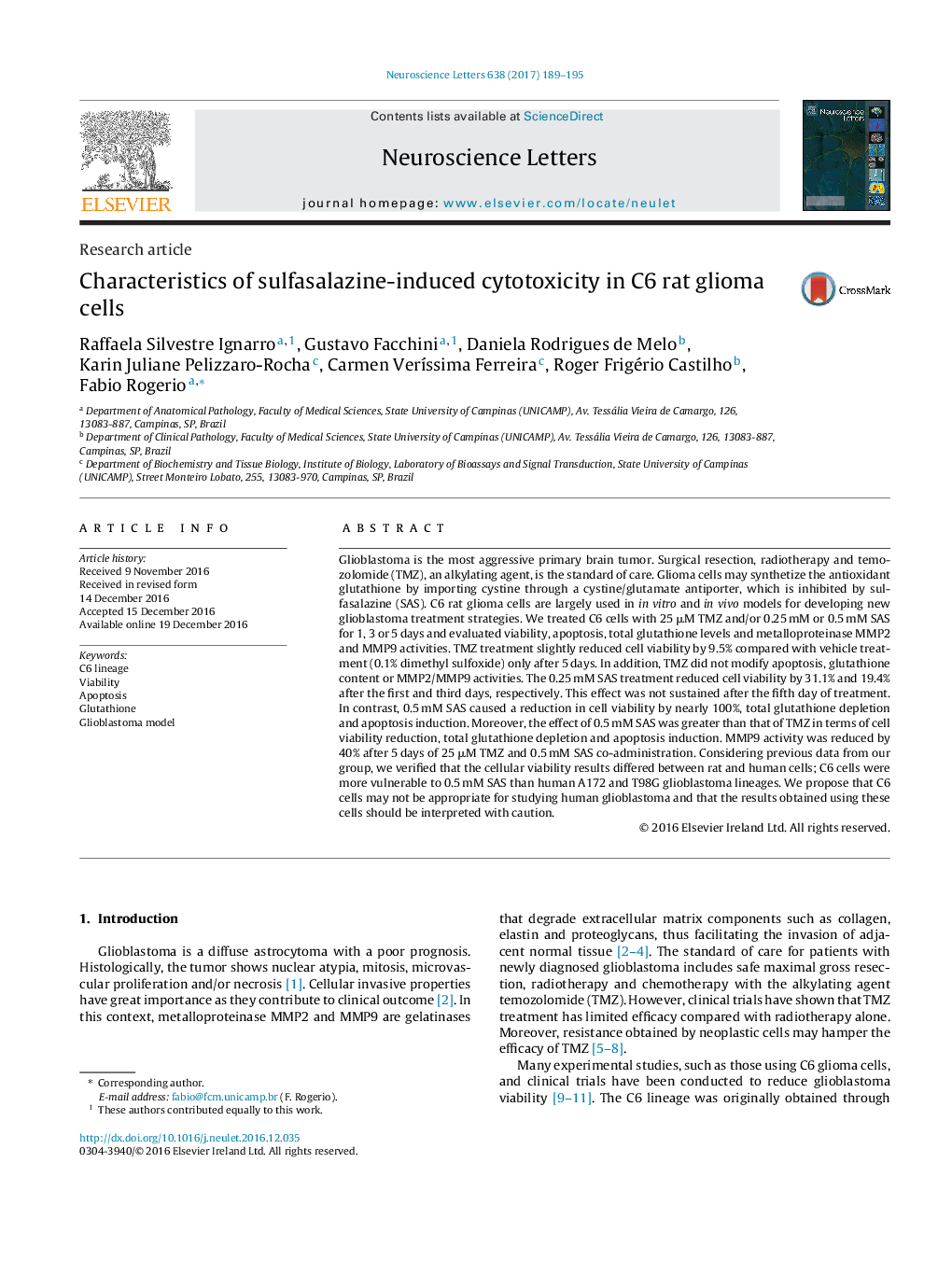| کد مقاله | کد نشریه | سال انتشار | مقاله انگلیسی | نسخه تمام متن |
|---|---|---|---|---|
| 5738870 | 1615061 | 2017 | 7 صفحه PDF | دانلود رایگان |
عنوان انگلیسی مقاله ISI
Characteristics of sulfasalazine-induced cytotoxicity in C6 rat glioma cells
دانلود مقاله + سفارش ترجمه
دانلود مقاله ISI انگلیسی
رایگان برای ایرانیان
موضوعات مرتبط
علوم زیستی و بیوفناوری
علم عصب شناسی
علوم اعصاب (عمومی)
پیش نمایش صفحه اول مقاله

چکیده انگلیسی
Glioblastoma is the most aggressive primary brain tumor. Surgical resection, radiotherapy and temozolomide (TMZ), an alkylating agent, is the standard of care. Glioma cells may synthetize the antioxidant glutathione by importing cystine through a cystine/glutamate antiporter, which is inhibited by sulfasalazine (SAS). C6 rat glioma cells are largely used in in vitro and in vivo models for developing new glioblastoma treatment strategies. We treated C6 cells with 25 μM TMZ and/or 0.25 mM or 0.5 mM SAS for 1, 3 or 5 days and evaluated viability, apoptosis, total glutathione levels and metalloproteinase MMP2 and MMP9 activities. TMZ treatment slightly reduced cell viability by 9.5% compared with vehicle treatment (0.1% dimethyl sulfoxide) only after 5 days. In addition, TMZ did not modify apoptosis, glutathione content or MMP2/MMP9 activities. The 0.25 mM SAS treatment reduced cell viability by 31.1% and 19.4% after the first and third days, respectively. This effect was not sustained after the fifth day of treatment. In contrast, 0.5 mM SAS caused a reduction in cell viability by nearly 100%, total glutathione depletion and apoptosis induction. Moreover, the effect of 0.5 mM SAS was greater than that of TMZ in terms of cell viability reduction, total glutathione depletion and apoptosis induction. MMP9 activity was reduced by 40% after 5 days of 25 μM TMZ and 0.5 mM SAS co-administration. Considering previous data from our group, we verified that the cellular viability results differed between rat and human cells; C6 cells were more vulnerable to 0.5 mM SAS than human A172 and T98G glioblastoma lineages. We propose that C6 cells may not be appropriate for studying human glioblastoma and that the results obtained using these cells should be interpreted with caution.
ناشر
Database: Elsevier - ScienceDirect (ساینس دایرکت)
Journal: Neuroscience Letters - Volume 638, 18 January 2017, Pages 189-195
Journal: Neuroscience Letters - Volume 638, 18 January 2017, Pages 189-195
نویسندگان
Raffaela Silvestre Ignarro, Gustavo Facchini, Daniela Rodrigues de Melo, Karin Juliane Pelizzaro-Rocha, Carmen VerÃssima Ferreira, Roger Frigério Castilho, Fabio Rogerio,